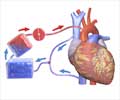- Cyanotic heart disease - (https://www.nlm.nih.gov/medlineplus/ency/article/001104.htm)
- Congenital Heart Defects - (http://www.heart.org/heartorg/conditions/congenitalheartdefects/congenital-heart-defects_ucm_001090_subhomepage.jsp)
What is Cyanotic Heart Disease?
Cyanotic heart disease or cyanotic heart defect refers to a group of congenital (present at birth) heart defects, which results in low blood oxygen levels.
These defects change the way blood flows through the heart and lungs, causing non-oxygenated blood to be pumped out to the body without going through the lungs to pick up oxygen. This condition results in less reaching the tissues of the body, leading to cyanosis or the development of bluish tint of the skin, lips and the nails.

Most of these defects have a significant impact on the child’s quality of life and could be life-threatening in some cases.
How does Blood Flow Normally through Heart and Lungs?
- Blood enters the right side of the heart through two large veins, the inferior and superior vena cava, which bring in blood that is low in oxygen from various parts of the body into the right atrium.
- Blood flows from your right atrium into your right ventricle through the open tricuspid valve.
- Blood is then taken to the lungs through the pulmonic valve by the pulmonary artery, where it picks up more oxygen and becomes red in color.
- The oxygen-rich blood is then taken from the lungs by the pulmonary artery to the left atrium.
- As the atrium contracts, blood flows from left atrium into left ventricle through the mitral valve, from where it is pumped by the aorta to the rest of the body.
What are the Causes of Cyanotic Heart Disease?
Although the exact cause of cyanotic heart disease cannot be pinpointed, it is believed that the following factors could play a major role:
- Genetic factors or family history of cyanotic heart disease
- Chromosomal defects (e.g., Down syndrome, trisomy 13, Turner syndrome)
- Heart valve defects such as defects in the tricuspid valve, aortic valve or pulmonary valve
- Exposure to toxic chemicals during pregnancy
- Infections during pregnancy such as rubella
- Gestational diabetes with poor control over blood sugar
- Certain medicines used during pregnancy - either prescribed by your physician or self-medication.
- Use of illegal drugs during pregnancy

Heart Defects that Cause Cyanotic Heart Disease
Tetralogy of Fallot (TOF)
It is the most common cause of cyanotic heart disease and comprises of four different defects namely a hole between the right and left ventricles of the heart, thickening of the muscles of the right ventricle, narrow pulmonary valve, and misplaced aortic valve.
Total Anomalous Pulmonary Venous Connection (TAPVC)
TAPVC results when veins that bring high-oxygen blood from the lungs to the heart are connected to the right atrium instead of the left atrium. Blockage in the vein between the lungs and the heart is also seen in some cases.
Transposition of the Great Arteries (TGA)
In this condition, the two main arteries leaving the heart are reversed or transposed, which changes the way blood is circulated in the body. The result is that low-oxygen blood gets pumped out all parts of the body through the aorta instead of going to the lungs for exchange of oxygen. Transposition of the great arteries is usually detected within hours to weeks after birth.
Truncus Arteriosus
In this condition, only a single blood vessel (truncus arteriosus) comes out of the right and left ventricles, instead of the normal blood vessels (pulmonary artery and aorta).
What are the Symptoms of Cyanotic Heart Disease?
- The most common symptom is cyanosis, which is basically a bluish discoloration of the skin due to less oxygen content. It may occur immediately after birth (infants with transposition of the great arteries) or may be identified several weeks after birth (babies with TOF)
- Dyspnea or difficulty in breathing
- Anxiety
- Tachypnea (rapid breathing)
- Syncope (fainting)
- Tiredness or sweating in infants while feeding
- Reduced appetite resulting in poor growth
- Chest pain

How do you Diagnose Cyanotic Heart Disease?
- Imaging tests like chest X-rays to see the location of several arteries and veins.
- Echocardiograms or ultrasound of the heart provides more details and could confirm the presence of defects.
- Cardiac catheterization, which involves using a small tube or a catheter, into the heart from the groin/arm area.
How do you Treat Cyanotic Heart Disease?
The treatment of cyanotic heart disease is based on the severity of the defects in the infant or child:
- Catheter: It involves inserting a catheter into an artery or a vein by making a small puncture in the skin. In this procedure there is no need to open the chest and operate directly on the heart, thus recovery is easier and faster. It is the preferred method of treatment in cases of simple heart defects such as pulmonary valve stenosis.
- Open-heart Surgery: It is used in cases, which cannot be treated using a catheter to close holes in the heart or to repair/replace heart valves or widen the openings to heart valves.

In severe cases, surgery or a combination of catheter and surgical procedures might be needed to correct the physical defects.
- Heart Transplant: This is needed in babies who have multiple heart defects which are complex in nature. In this case, the baby’s heart is replaced with a donor heart from a deceased child.
- Medications: Drugs are prescribed based on the nature of the heart defect and the degree of symptoms exhibited. Some of the medications used are ‘diuretics’ to eliminate extra fluids from the body and make breathing easier, anti-arrhythmic drugs to regulate abnormal heart rhythms and increase the strength at which the heart pumps the blood.










